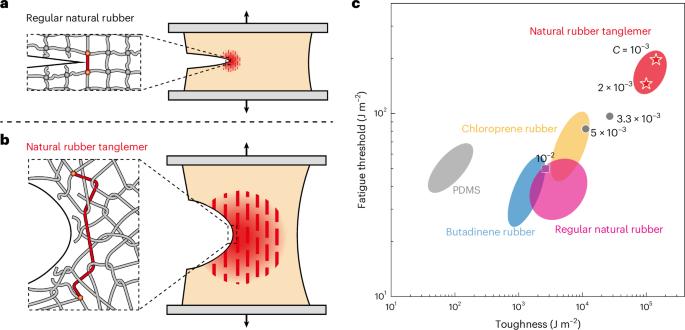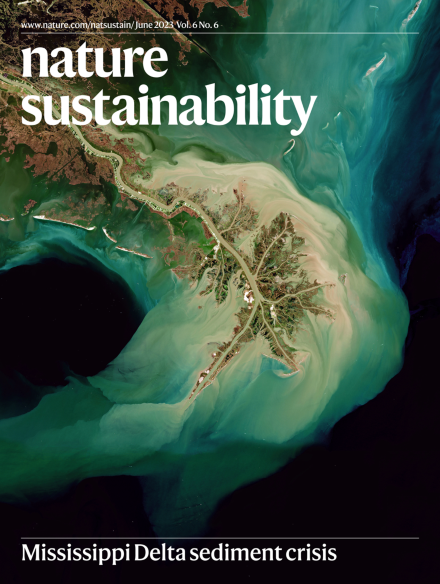天然橡胶,抗裂纹扩展能力强
IF 27.1
1区 环境科学与生态学
Q1 ENVIRONMENTAL SCIENCES
引用次数: 0
摘要
天然橡胶是最常用的生物弹性体,年产量为1500万吨。提高其抗裂纹扩展能力是非常需要的,以延长其在许多应用中的使用寿命,并最终提高其可持续性。在这里,我们通过形成缠结物来显著增强天然橡胶对裂纹增长的抵抗力,缠结物是一种聚合物网络,其中缠结大大超过交联。具体来说,我们铸造天然胶乳,没有高强度的加工,切割长聚合物。长聚合物通过热运动紧密缠绕,然后稀疏交联。在裂纹尖端,相邻交联之间的长聚合物链分散应力,将应变诱导结晶扩展到一个大区域,并提高结晶度。例如,当交联与重复单元的比例从10−2减少到10−3时,网络的疲劳阈值从~50 J m−2增加到~200 J m−2,韧性从~104 J m−2增加到超过105 J m−2。总的来说,这项工作为提高天然橡胶的实际适用性提供了一个可行的策略,有助于可持续聚合物的发展。天然橡胶是一种应用广泛的生物聚合物,进一步提高其抗裂缝生长能力将延长其使用寿命。在这里,作者展示了一种通过形成缠结剂来增强天然橡胶抗裂纹增长的策略。本文章由计算机程序翻译,如有差异,请以英文原文为准。

Natural rubber with high resistance to crack growth
Natural rubber, with annual production of 15 million tonnes, is the most used bio-elastomer. Improving its resistance to crack growth is highly desired, to prolong its service life for many applications and eventually improve its sustainability. Here we markedly amplify the resistance to crack growth in natural rubber by forming a tanglemer, a polymer network in which entanglements greatly outnumber crosslinks. Specifically, we cast natural rubber latex without high-intensity processing that cuts long polymers. The long polymers densely entangle by thermal motion and are then sparsely crosslinked. At a crack tip, long polymer strands between neighbouring crosslinks deconcentrate stress, extend strain-induced crystallization over a large region and enhance crystallinity. For example, when the ratio of crosslinks to repeat units reduces from 10−2 to 10−3, the network amplifies fatigue threshold from ~50 J m−2 to ~200 J m−2, and toughness from ~104 J m−2 to over 105 J m−2. Overall, this work provides a viable strategy to improve the practical applicability of natural rubber, contributing to the development of sustainable polymers. Natural rubber is a widely used biopolymer and further improving its resistance to crack growth will extend its service life. Here the authors show a strategy to amplify the resistance to crack growth in natural rubber by forming a tanglemer.
求助全文
通过发布文献求助,成功后即可免费获取论文全文。
去求助
来源期刊

Nature Sustainability
Energy-Renewable Energy, Sustainability and the Environment
CiteScore
41.90
自引率
1.10%
发文量
159
期刊介绍:
Nature Sustainability aims to facilitate cross-disciplinary dialogues and bring together research fields that contribute to understanding how we organize our lives in a finite world and the impacts of our actions.
Nature Sustainability will not only publish fundamental research but also significant investigations into policies and solutions for ensuring human well-being now and in the future.Its ultimate goal is to address the greatest challenges of our time.
 求助内容:
求助内容: 应助结果提醒方式:
应助结果提醒方式:


